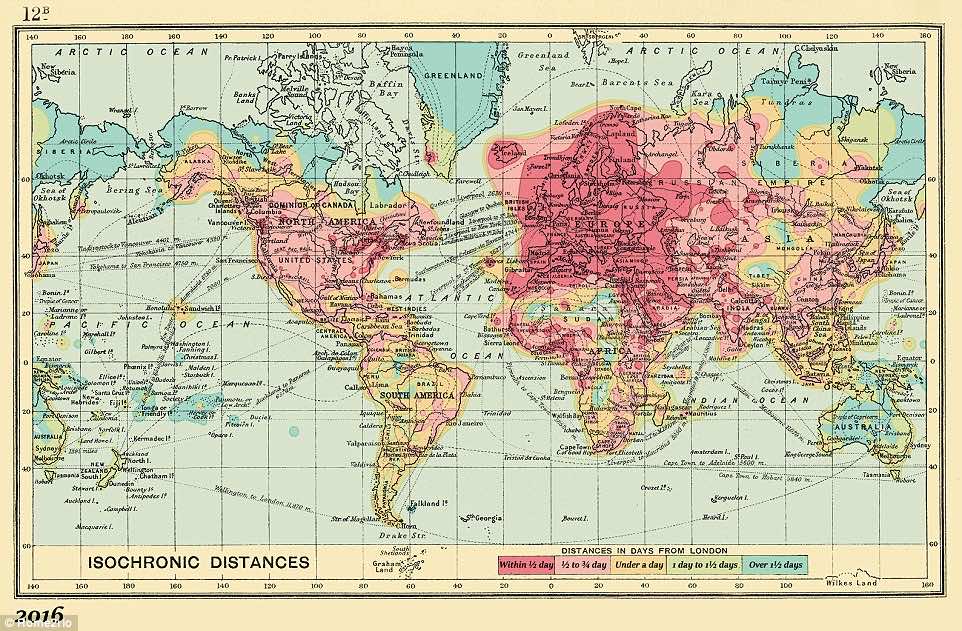Recently, the internet was buzzing with this interesting set of maps that highlighted the reduction in travelling times between 1914 and 2016. Nearly a century ago, there were few aircraft and the ocean liners like HMS Titanic were slower than the speedy ones like MS Oasis of the Seas available for us today. It was only after the end of the First World War that aviation technology had progressed to a point that the first commercial airliners were launched. So, in 1914, the average traveller had to undertake a 10-days journey to reach New York from London. In 2016, the journey takes a little under 8 hours. If the Concorde were operational today, it would have been just three hours! So, a remarkable inverse exponential increase has been seen in the reduction of traveling times in the last century.
Here is the map with a focus on the time it takes to travel from London to other parts of the world.
The Red areas are where a person can reach within half a day or 12 hours. The pink areas are where he can reach within three-quarters of a day. The yellow areas, on the other hand, are where one can reach within 24 hours mark. The green days show farther away areas that can be reached within 36 hours or 1 1/2 days. Blue is the color for most far-flung areas that probably take more than 1 1/2 days to travel. This concept is called Isochronic map. Isochronic areas are which can be reached within a specific time limit. Areas with a specific color are all isochronic. Rome2rio was the company behind the creation of this amazing map and took data from 750,000 routes and from 4,800 travel agents to come to this graphic solution spread over 144 countries.
Here is another isochronic map, but it is from 1914. You can see the real difference with the help of this map!
So, the maximum time it took in 1914 was over 40 days. These areas weren’t even that far-flung as well like inner parts of South America, Africa and China. It mostly took that long because ships were slower, road networks were poorer, trains and cars were much slower and also people didn’t travel that much and this frequently. When World War I broke out, soldiers from Australia and New Zealand, both Allied nations took several days to reach the German colonies in South East Asia like New Guinea. British soldiers also took many days to arrive in the main battlegrounds of France and Turkey. It also took British 20 days to reach India – their largest colony in the world. How they managed to keep things in order with a twenty days gap is a feat indeed.
Interestingly, this map was first published in 1914 as a means to show the world how “fast” the traveling had been made due to the advent of mechanized trains. Most of the world could be reached within a month or so. If you look at the accounts of history, this was quite an achievement at that time as Marco Polo and Ibn e Batuta, the great travellers of the Renaissance age took 3-5 years to travel to China one-way as they show it in their accounts. You may have heard about the novel named “Around the World in Eighty Days” from the late Nineteenth century. This was unbelievable for many people that the world could be circumnavigated in such a short period!
This map was first published by G Bartholomew in An Atlas of Economic Geography. As we can see that Greenland and several far-flung areas still take several days to reach. It is not because of the speed of the aircraft is low. It is because these aren’t conventional routes at all. We can all agree that generally, the life has improved beyond measure across the world for travellers. But, it didn’t happen in a century as it is portrayed in these maps. It happened in even less amount of time as the Boeing 747 was first launched in the 1970s. Also, soon after the World War I, commercial flights started and the world became much more connected and approachable for people. So, most of the time reduction took place between 1920-1970, only fifty years! Let’s hope it continues the same pace again as it has stalled in recent decades!

